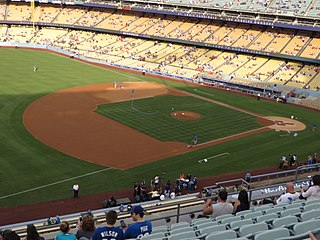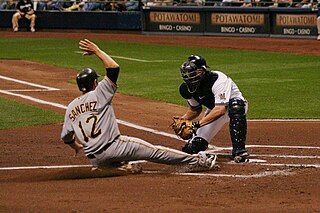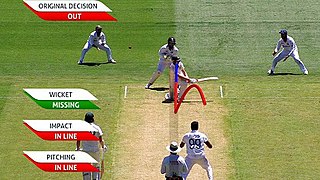In cricket, an umpire is a person who has the authority to make decisions about events on the cricket field according to the Laws of Cricket. Besides making decisions about legality of delivery, appeals for wickets and general conduct of the Game in a legal manner, the umpire also keeps a record of the deliveries and announces the completion of an over.

A referee is an official, in a variety of sports and competition, responsible for enforcing the rules of the sport, including sportsmanship decisions such as ejection. The official tasked with this job may be known by a variety of other titles depending on the sport, including umpire, judge, arbiter (chess), commissaire, or technical official. Referees may be assisted by umpires, linesmen, timekeepers, touch judges, or video review officials.
The Laws of Cricket is a code that specifies the rules of the game of cricket worldwide. The earliest known code was drafted in 1744. Since 1788, the code has been owned and maintained by the private Marylebone Cricket Club (MCC) in Lord's Cricket Ground, London. There are currently 42 Laws, which describe all aspects of how the game is to be played. MCC has re-coded the Laws six times, each with interim revisions that produce more than one edition. The most recent code, the seventh, was released in October 2017; its 3rd edition came into force on 1 October 2022.
The ICC Cricket Code of Conduct is a regulation regarding the conduct of professional players in the sport of cricket. Traditionally, cricket requires "gentlemanly" conduct from all players. The Code of Conduct is written and enforced by the International Cricket Council.

This is a general glossary of the terminology used in the sport of cricket. Where words in a sentence are also defined elsewhere in this article, they appear in italics. Certain aspects of cricket terminology are explained in more detail in cricket statistics and the naming of fielding positions is explained at fielding (cricket).

In association football, the referee is the person responsible for interpreting and enforcing the Laws of the Game during a match. The referee is the final decision-making authority on all facts connected with play, and is the match official with the authority to start and stop play and impose disciplinary action against players and coaches during a match.
Dead ball is a term in many ball sports in which the ball is deemed temporarily not playable, and no movement may be made with it. Depending on the sport, this event may be quite routine, or more uncommon.
A match referee is an official appointed to oversee professional cricket matches. Match referees for Test matches and One Day Internationals are appointed by the International Cricket Council (ICC). Most matches below international level do not have a referee.

In cricket, an appeal is the act of a player on the fielding team asking an umpire for a decision regarding whether a batter is out or not. According to Law 31 of the Laws of Cricket, an umpire may not rule a batter out unless the fielding side appeals for a decision. However, in practice most umpires will give a batter out to an obvious bowled or caught. On many occasions when a batter has otherwise technically been out, the fielding team has not realised, so neglected to appeal, and so the umpire has not declared them out. An appeal may be made at any point before the bowler starts their run-up for the next ball.

Infield is a sports term whose definition depends on the sport in whose context it is used.
An umpire in field hockey is a person with the authority to make decisions on a hockey pitch in accordance with the rules of the game. Each match is controlled by two such umpires. In theory they are responsible for decisions taken on their respective half of the field, but practically they 'control' on either diagonal half of the field. In many higher-level events, a reserve umpire is appointed in addition to the two field umpires to act as a back-up in the event of injury or other issue preventing a field umpire from commencing or continuing a match. In World-Level competitions, a video umpire is also appointed in addition to the field and reserve umpires.
Instant replay or action replay is a video reproduction of something that recently occurred which was both shot and broadcast live.

In baseball, blocking the plate is a technique performed by a catcher to prevent a runner from scoring. The act of blocking the plate accounted for most of the physical contact in Major League Baseball prior to the 2014 season, when it was outlawed except when the catcher already has possession of the ball.
A variety of sports are played in British Overseas Territory of Bermuda, from those brought by British and International relations, and sail racing). Some sports and events have greater historical and cultural significance whilst others are played for entertainment or competition.

In sports, an ejection is the removal of a participant from a contest due to a violation of the sport's rules. The exact violations that lead to an ejection vary depending upon the sport, but common causes for ejection include unsportsmanlike conduct, violent acts against another participant that are beyond the sport's generally accepted standards for such acts, abuse against officials, violations of the sport's rules that the contest official deems to be egregious, or the use of an illegal substance to better a player's game. Most sports have provisions that allow players to be ejected, and many allow for the ejection of coaches, managers, or other non-playing personnel. In sports that use penalty cards, a red card is often used to signal dismissals. In some sports, another player is permitted to enter the game in place of the player who has been ejected, but in others the team is required to continue the game with a reduced number of players.

Penalty cards are used in many sports as a means of warning, reprimanding or penalising a player, coach or team official. Penalty cards are most commonly used by referees or umpires to indicate that a player has committed an offence. The official will hold the card above their head while looking or pointing toward the player who has committed the offence. This action makes the decision clear to all players, as well as spectators and other officials in a manner that is language-neutral. The colour or shape of the card used by the official indicates the type or seriousness of the offence and the level of punishment that is to be applied. Yellow and red cards are the most common, typically indicating, respectively, cautions and dismissals.

Unsportsmanlike conduct is a foul or offense in many sports that violates the sport's generally accepted rules of sportsmanship and participant conduct. Examples include verbal abuse or taunting of an opponent or a game official, an excessive celebration following a significant play, or feigning injury. The official rules of many sports include a general provision whereby participants or an entire team may be penalized or otherwise sanctioned for unsportsmanlike conduct.

Cricket is a bat-and-ball game played between two teams of eleven players on a field at the centre of which is a 22-yard (20-metre) pitch with a wicket at each end, each comprising two bails balanced on three stumps. Two players from the batting team stand in front of either wicket, with one player from the fielding team bowling the ball towards the striker's wicket from the opposite end of the pitch. The striker's goal is to hit the bowled ball and then switch places with the nonstriker, with the batting team scoring one run for each exchange. Runs are also scored when the ball reaches or crosses the boundary of the field or when the ball is bowled illegally.

The Decision Review System (DRS), formerly known as the Umpire Decision Review System(UDRS), is a technology-based system used in cricket to assist the match officials in their decision-making. On-field umpires may choose to consult with the third umpire (known as an Umpire Review), and players may request that the third umpire consider a decision of the on-field umpires (known as a Player Review).














